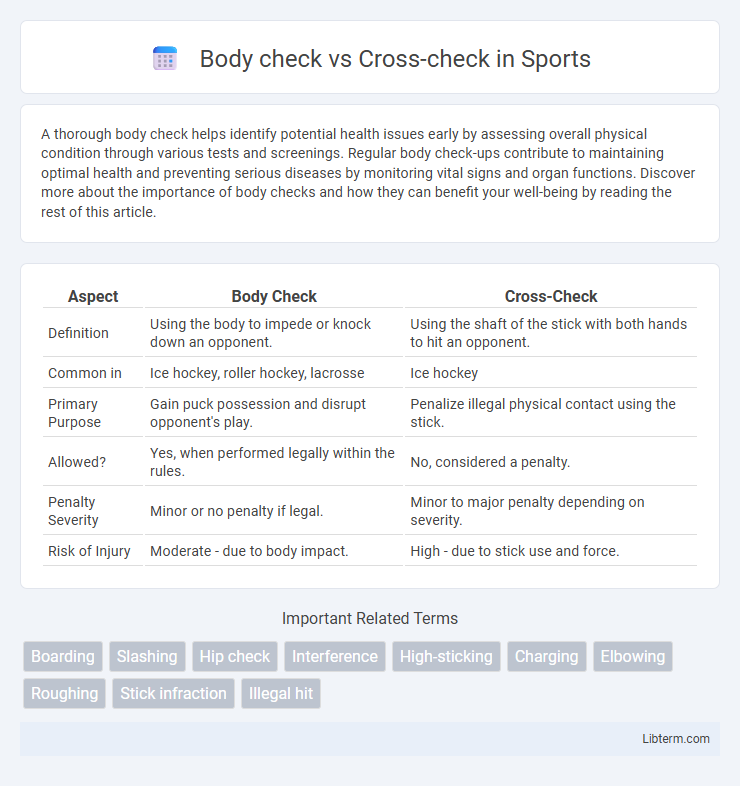A thorough body check helps identify potential health issues early by assessing overall physical condition through various tests and screenings. Regular body check-ups contribute to maintaining optimal health and preventing serious diseases by monitoring vital signs and organ functions. Discover more about the importance of body checks and how they can benefit your well-being by reading the rest of this article.
Table of Comparison
| Aspect | Body Check | Cross-Check |
|---|---|---|
| Definition | Using the body to impede or knock down an opponent. | Using the shaft of the stick with both hands to hit an opponent. |
| Common in | Ice hockey, roller hockey, lacrosse | Ice hockey |
| Primary Purpose | Gain puck possession and disrupt opponent's play. | Penalize illegal physical contact using the stick. |
| Allowed? | Yes, when performed legally within the rules. | No, considered a penalty. |
| Penalty Severity | Minor or no penalty if legal. | Minor to major penalty depending on severity. |
| Risk of Injury | Moderate - due to body impact. | High - due to stick use and force. |
Understanding Body Check: Definition and Purpose
Body check is a defensive technique in ice hockey used to disrupt an opponent's possession and create turnovers by using the body to impede progress. The main objective of a body check is to separate the puck carrier from the puck without committing a penalty, emphasizing physical control and positioning. Proper execution of body checks enhances team defense and reduces scoring opportunities for the opposing team.
What is Cross-Check in Hockey?
Cross-checking in hockey is an illegal body check where a player uses the shaft of their stick, held with both hands, to forcefully push or hit an opponent. This action often results in penalties due to its high risk of injury and unsportsmanlike conduct. Proper enforcement of cross-checking rules helps maintain player safety and fair play during the game.
Key Differences Between Body Check and Cross-Check
A body check in hockey involves using the torso to legally impede an opponent, targeting the midsection to separate the player from the puck. In contrast, a cross-check uses the shaft of the stick held with both hands to forcefully hit an opponent, which is typically penalized due to increased risk of injury. The key difference lies in the method of contact: body checking is physical and allowed under specific rules, while cross-checking is considered dangerous and often results in penalties.
Legal vs. Illegal Contact: Rules and Regulations
Body checks are legal in ice hockey when delivered to an opponent in possession of the puck within the allowable playing zone, following specific size and timing requirements to ensure player safety. Cross-checks, involving using the shaft of the stick with both hands to forcefully hit an opponent, are predominantly classified as illegal due to their higher risk of injury and typically result in penalties under league rules. Hockey regulations emphasize distinguishing between permissible body contact and forbidden cross-checking actions to maintain fair play and reduce on-ice injuries.
Techniques for Effective Body Checking
Effective body checking relies on proper positioning, balance, and timing to legally disrupt an opponent's movement by using the torso or shoulder while maintaining control of the puck. Key techniques include keeping a low center of gravity, driving with the hips, and targeting the opponent's midsection to minimize penalty risk and maximize impact. Mastery of body checking requires anticipation, footwork, and physical strength to execute clean hits within the rules of hockey.
Risks and Penalties of Cross-Checking
Cross-checking in hockey involves using the shaft of the stick with both hands to hit an opponent, which significantly increases the risk of injury due to its forceful and uncontrolled nature. Penalties for cross-checking are severe, often resulting in minor, major penalties, or game misconducts, reflecting the sport's emphasis on player safety. Body checking, while also physical, is regulated to minimize injury risk and typically draws fewer penalties when executed legally within the rules.
Safety Considerations in Checking
Body checking in hockey involves using the hips and shoulders to legally separate an opponent from the puck, prioritizing player safety by maintaining controlled contact within the rules. Cross-checking, which entails forcefully striking an opponent with the shaft of the stick held with both hands, poses higher risks of injury and is penalized to discourage dangerous play. Safety considerations emphasize proper technique and rule enforcement to minimize concussion and injury risks associated with physical contact during the game.
The Role of Referees in Enforcing Checks
Referees play a critical role in enforcing body checks and cross-checks by closely monitoring physical contact to ensure player safety and game fairness. Body checks, which involve legal shoulder-to-shoulder contact, require referees to differentiate them from cross-checks, characterized by using the shaft of the stick against an opponent, often resulting in penalties. Accurate enforcement by referees relies on understanding the intent and execution of checks, maintaining game flow while minimizing dangerous play.
Impact of Body and Cross-Checks on Game Flow
Body checks in hockey create physical pressure that can disrupt an opponent's possession and momentum, often leading to turnovers and shifts in control, thereby influencing the pace of the game. Cross-checks, being illegal and penalized, frequently result in power plays that alter team dynamics and interrupt the natural flow, causing stoppages and potential scoring opportunities for the opposing team. The strategic use of legal body checks maintains aggressive gameplay and physicality, while cross-checks tend to slow the game and increase disciplinary consequences.
Training and Conditioning for Safe Checking
Training and conditioning for safe body checking and cross-checking emphasize proper techniques to minimize injury risks in hockey. Developing core strength, balance, and flexibility through targeted exercises enhances stability and control during physical contact. Consistent practice under professional supervision ensures players execute checks safely while maintaining adherence to game rules and preventing penalties.
Body check Infographic

 libterm.com
libterm.com